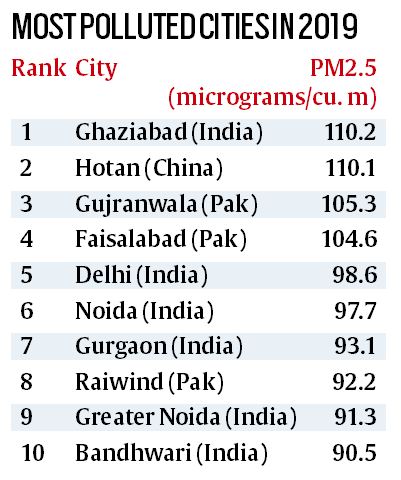Biodiversity & Environment
World Air Quality Report 2019
- 26 Feb 2020
- 3 min read
Why in News
India was the fifth most polluted country in 2019 and accounts for almost two-thirds of the world’s most polluted cities according to the World Air Quality Report 2019.
- The report was released by the pollution tracker IQAir and Greenpeace.
- The ranking is based on a comparison of PM 2.5 levels.
PM 2.5
- It is an atmospheric particulate matter of diameter of fewer than 2.5 micrometres, which is around 3% the diameter of a human hair.
- It causes respiratory problems and also reduces visibility. It is an endocrine disruptor that can affect insulin secretion and insulin sensitivity, thus contributing to diabetes.
- It is very small and can only be detected with the help of an electron microscope.
Key Points
- Bangladesh emerged as the most polluted country for PM 2.5 exposure followed by Pakistan, Mongolia, Afghanistan and India.
- 21 of the 30 most polluted cities in the world are located in India with Ghaziabad in the National Capital Region ranked the world’s most polluted.
- Indian cities, on average, exceed the World Health Organisation (WHO) target for annual PM 2.5 exposure by 500%.
- For example, Mumbai’s annual PM 2.5 concentration is 45.3 micrograms/cubic metre, when it should be 10 micrograms/cubic metre according to the WHO.
- However, national air pollution decreased by 20% from 2018 to 2019, with 98% of cities experiencing improvements.
- India launched a National Clean Air Programme (NCAP) in 2019 that commits to reducing air pollution in 102 most polluted cities by a maximum of 30% by 2024.
- The report, however, noted that the reduction in pollution in 2019 couldn’t be attributed to the NCAP but to the slowing of the marketplace.
- According to the Economic Survey 2019-20, the economic growth rate in India is expected to slow down to 5% in 2019-20 from 6.1% in 2018-19 and 7% in 2017-18.
- The Report highlights elevated air pollution levels as a result of climate change events, such as sandstorms, wildfires and pollution gains from the rapid urbanization of cities in regions such as Southeast Asia.
- While some achievements have been made in air quality monitoring infrastructure globally, there are still huge gaps in access to data around the world.
- It is to be noted that the World Air Quality Report is different from the State Of Global Air Report which is produced by the Boston-based Health Effects Institute (HEI).






